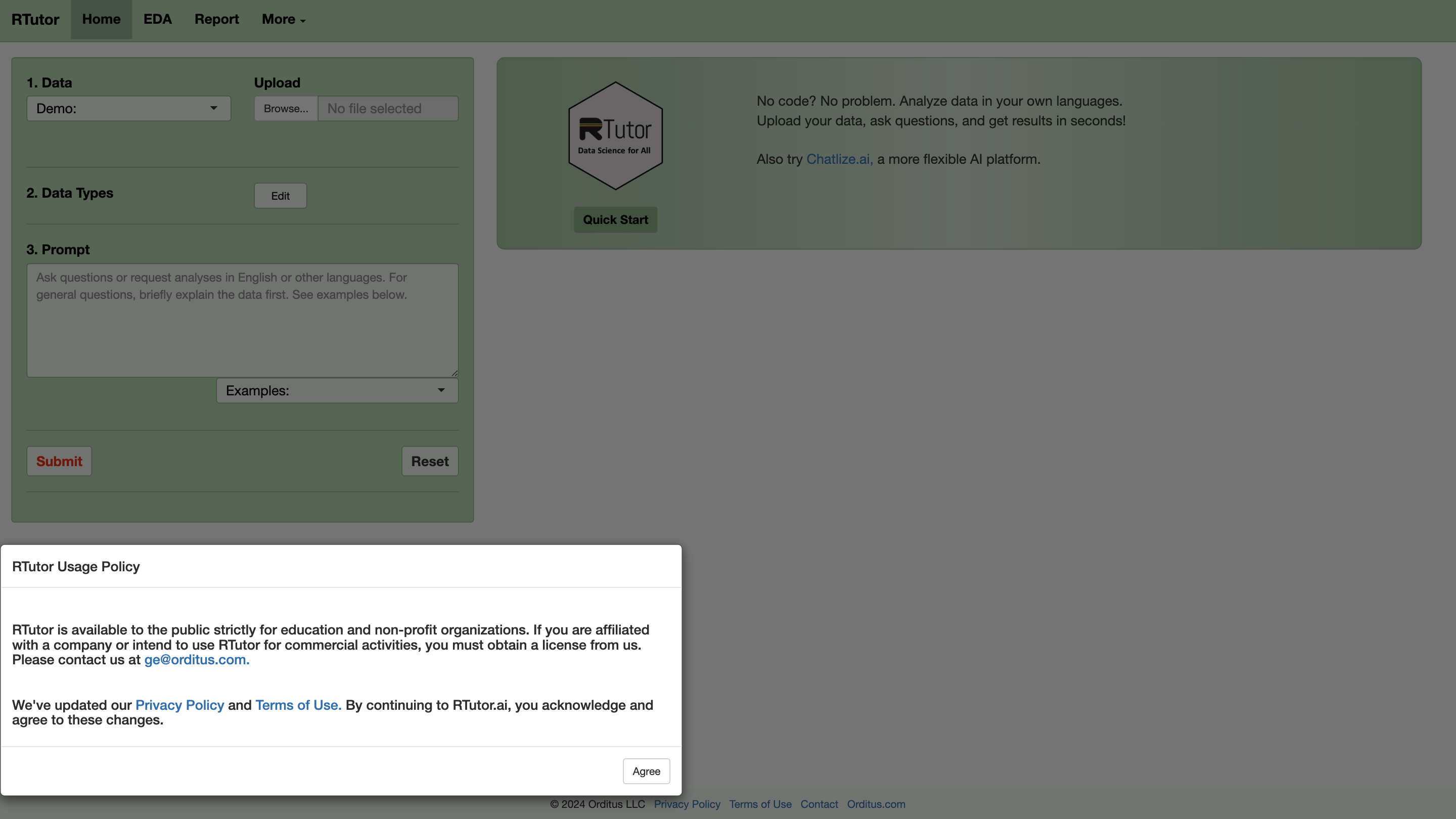RTutor
Open siteIntroduction
Summary: RTutor is an AI-based app for data analysis using natural language.
RTutor Product Information
RTutor (AI-assisted R/Python Coding for Data Analysis) is an AI-powered tool by Orditus LLC that translates natural language prompts into executable R or Python code to analyze data. It focuses on Exploratory Data Analysis (EDA) and supports Python and R code generation, integrated via a GPT-based model. The platform emphasizes interactive data exploration, quick code generation, and the ability to download results as HTML reports. It is designed for both beginners and advanced users to analyze datasets (CSV, Excel, etc.) and produce reproducible code and results.
How RTutor Works
- Upload your dataset (CSV, TSV, Excel) to load into a working data frame (df).
- Ask questions or describe the analysis you want in natural language.
- RTutor translates the request into R or Python code, executes it, and returns results including plots, summaries, and reports.
- The session can be continued with context from previous questions and code chunks.
- Generated code can be refined iteratively; users can reset to start over or adjust prompts.
How to Use RTutor
- Upload your data. Choose a CSV, TSV, or Excel file. RTutor loads the data into a data frame named df.
- Ask questions or request analyses. Examples: distributions, correlations, visualizations, summary tables, or custom analyses.
- Review and run the generated code. RTutor provides R or Python code and executes it to display results.
- Download a report. Generate an HTML report containing code, results, and plots.
Disclaimer: Generated code may contain errors or require validation; treat results as starting points for refinement.
Core Features
- Natural language to R or Python code translation
- Supports data upload from CSV, TSV, Excel formats
- Interactive data exploration with summaries, plots, and correlations
- Generates runnable code that can be edited and re-executed
- HTML report export of code, results, and visuals
- Context-aware session: previous prompts influence subsequent results
- No data storage on the server after the session ends
Data Handling and Privacy
- Data is loaded into a working data frame (df) for analysis during the session.
- Data is not stored on the web server after the session ends.
- Users can opt to include or exclude dataset samples sent to the language model for enhanced results.
- Privacy policy and terms govern data usage and protection.
Use Cases
- Quick EDA: distributions, central tendency, variability, and outliers
- Statistical summaries: correlations, group comparisons, and basic modeling prompts
- Visualization generation: histograms, boxplots, scatterplots, and multi-plot layouts
- Reproducible reporting: HTML reports with code and results for sharing
Safety and Legal Considerations
- Generated code may be imperfect; validate results before relying on them for critical decisions.
- Follow applicable data privacy laws and organizational policies when uploading data.
Basic Terminology and Workflow Notes
- df: the main data frame containing the uploaded dataset
- Code generation: the AI translates natural language prompts into executable R or Python snippets
- Session context: prior prompts and outputs influence subsequent code and plots
Getting Started Tips
- Name your columns clearly in the source data to help the AI infer data types and roles (numeric vs. categorical).
- Start with simple requests (e.g., describe distributions, compute summary statistics) and gradually increase complexity.
- When requesting plots, specify axes, groups, or facets to guide visualization.
License and Availability
RTutor is available through Orditus LLC with licensing options for commercial use and options to customize and locally install for enterprise deployments. See the Privacy Policy and Terms of Use for details.
Safety and Legal Considerations Summary
- Use the tool for legitimate data analysis and do not misuse AI-generated outputs.
- Respect data privacy; avoid uploading confidential information without proper anonymization.
Core Features Summary
- Natural language to executable R or Python code
- Data upload support for CSV, TSV, and Excel
- Interactive EDA with summaries, correlations, and visualizations
- Code generation with editable and reusable outputs
- HTML report export
- Session context for progressive analysis
- Data privacy: no persistent storage of uploaded data after session
